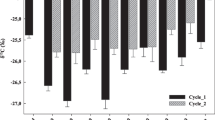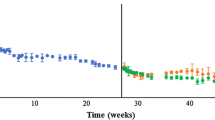Abstract
We have studied the effect of anaerobically digested (ADMSW) and composted municipal solid waste (CMSW) on mineralization and foodweb dynamics to verify the hypothesis that ADMSW would immobilize N right after addition to soil in contrast to addition with CMSW. Another hypothesis was that the mesofauna (enchytraeids and microarthropods) would stimulate N release from the decomposer community. We measured excretion of \( {\text{NH}}^{{\text{ + }}}_{{\text{4}}} \)-N and urea-N from the mesofauna and hypothesized that enchytraeids would release urea. ADMSW and CMSW were amended to pots with sandy loam and barley. The pots were divided into treatments with or without mesofauna. Mesofauna, plant N and biomass, soil N and ergosterol (fungal biomass) were measured over a 113-day period of four equidistant samplings. Soil respiration, N mineralization and N release by the mesofauna were modelled from concurrent studies. ADMSW- and CMSW-treated soils initially (<20 days) immobilized N. The amendments did not increase plant growth substantially, and this was probably due to N-limitation in the early stages of plant growth. Enchytraeid abundance was about three times higher in ADMSW- than CMSW-treated soils, indicating that ADMSW contained more labile compounds, bacteria, and microfauna. The mesofauna did not affect N-content, but the cumulated \( {\text{NH}}^{{\text{ + }}}_{{\text{4}}} \)-N excreted by the mesofauna was estimated to be substantial and about one-fifth of total plant N in ADMSW. An explanation for this discrepancy might be that in the absence of the mesofauna, other members of the detrivore and microbivore community performed the mesofauna’s function. Neither enchytraeids nor microarthropods excreted urea.



Similar content being viewed by others
References
Amlinger F, Gotz B, Dreher P, Geszti J, Weissteiner C (2003) Nitrogen in biowaste and yard waste compost: dynamics of mobilisation and availability—a review. Eur J Soil Biol 39:107–116
Anderson JM, Ineson P, Huish SA (1983) Nitrogen and cation mobilization by soil fauna feeding on leaf litter and soil organic matter from deciduous woodlands. Soil Biol Biochem 15:463–467
Andrén O, Schnürer J (1985) Barley straw decomposition with varied levels of microbial grazing by Folsomia fimetaria (L.). Oecologia 68:57–62
Berg MP, Stoffer M, van den Heuvel HH (2004) Feeding guilds in Collembola based on digestive enzymes. Pedobiologia 48:589–601
Bernal MP, Sanchez-Monedero MA, Paredes C, Roig A (1998) Carbon mineralization from organic wastes at different composting stages during their incubation with soil. Agric Ecosyst Environ 69:175–189
Bower CE, Holm-Hansen T (1980) A salicylate–hypochlorite method for determining ammonia in seawater. Can J Fish Aquat Sci 37:794–798
Brandt KK, Krogh PH, Cassani G, Sørensen J (2000) Does LAS affect the soil ecosystem in sludge-amended soil? Results from a field trial with well-defined strings of LAS-amended sludge in soil. 5th World Surfactants Congress, Fortezza da Basso, Firenze. May 29–June 2, 2000. CESIO
Bruckner A, Kampichler C, Wright J, Bauer R, Kandeler E (1995) A method of preparing mesocosms for assessing complex biotic processes in soils. Biol Fertil Soils 19:257–262
Brussaard L, Behan-Pelletier VM, Bignell DE, Brown VK, Didden W, Folgarait P, Fragoso C, Freckman DW, Gupta V, Hattori T, Hawksworth DL, Klopatek C, Lavelle P, Malloch DW, Rusek J, Soderstrom B, Tiedje JM, Virginia RA (1997) Biodiversity and ecosystem functioning in soil. Ambio 26:563–570
Bruun S, Hansen TL, Christensen TH, Magid J, Jensen LS (2006) Application of processed organic municipal solid waste on agricultural land—a scenario analysis. Environ Model Assess 11:251–265
Chamberlain PM, Bull ID, Black HIJ, Ineson P, Evershed RP (2006) Collembolan trophic preferences determined using fatty acid distributions and compound-specific stable carbon isotope values. Soil Biol Biochem 38:1275–1281
Cole L, Bardgett RD, Ineson P (2000) Enchytraeid worms (Oligochaeta) enhance mineralization of carbon in organic upland soils. Eur J Soil Sci 51:185–192
Coleman DC, DA Crossley Jr (1996) Fundamentals of soil ecology. Academic, Georgia
Cortet J, Joffre R, Elmholt S, Krogh PH (2003) Increasing species and trophic diversity of mesofauna affects fungal biomass, mesofauna community structure and organic matter decomposition processes. Biol Fertil Soils 37:302–312
de Ruiter PC, Moore JC, Zwart KB, Bouwman LA, Hassink J, Bloem J, Devos JA, Marinissen JCY, Didden WAM, Lebbink G, Brussaard L (1993) Simulation of nitrogen mineralization in the belowground food webs of two winter wheat fields. J Appl Ecol 30:95–106
Didden WAM (1993) Ecology of terrestrial enchytraeidae. Pedobiologia 37:2–29
Edwards CA, Lofty JR (1977) Biology of earthworms, 2nd edn. Chapman and Hall, London
Ek H, Sjogren M, Arnebrant K, Soderstrom B (1994) Extramatrical mycelial growth, biomass allocation and nitrogen uptake in ectomycorrhizal systems in response to collembolan grazing. Appl Soil Ecol 1:155–169
Filser J (1995) The effect of green manure on the distribution of Collembola in a permanent row crop. Biol Fert Soils 19:303–308
Filser J, Krogh PH (2002) Interactions between Enchytraeus crypticus, collembolans, gamasid mites and barley plants—a greenhouse experiment. In: Christensen B and Standen V (eds) Natura jutlandica occasional papers No. 2. Mols, Denmark, pp 32–42
Gabrielle B, Da-Silveira J, Houot S, Michelin J (2005) Field-scale modelling of carbon and nitrogen dynamics in soils amended with urban waste composts. Agric Ecosyst Environ 110:289–299
Gallardo-Lara F, Nogales R (1987) Effect of the application of town refuse compost on the soil–plant system: a review. Biol Wastes 19:35–62
Giusquiani PL, Pagliai M, Gigliotti G, Businelli D, Benetti A (1995) Urban waste compost—effects on physical, chemical, and biochemical soil properties. J Environ Qual 24:175–182
Hadley NF (1994) Water relations of terrestrial arthropods. Academic, San Diego
Hartl W, Putz B, Erhart E (2003) Influence of rates and timing of biowaste compost application on rye yield and soil nitrate levels. Eur J Soil Biol 39:129–139
Hodge A, Stewart J, Robinson D, Griffiths BS, Fitter AH (2000) Competition between roots and soil micro-organisms for nutrients from nitrogen-rich patches of varying complexity. J Ecol 88:150–164
Hopkin SH (1997) Biology of the springtails (Insecta: Collembola). Oxford University Press, New York
Larsen T, Axelsen J, Ravn HW (2004) Simplified and rapid method for extraction of ergosterol from natural samples and detection with quantitative and semi-quantitative methods using thin-layer chromatography. J Chromatogr A 1026:301–304
Leifeld J, Siebert S, Kogel-Knabner I (2002) Biological activity and organic matter mineralization of soils amended with biowaste composts. J Plant Nutr Soil Sci 165:151–159
Luxhøi J, Bruun S, Jensen A, Larsen T, Jensen LS, Magid J (2007) Modeling C and N mineralization during decomposition of degassed and composted household waste. Waste Manage Res 25:1–7
Malhi SS, Lemke R, Wang ZH, Chhabra BS (2006) Tillage, nitrogen and crop residue effects on crop yield, nutrient uptake, soil quality, and greenhouse gas emissions. Soil Tillage Res 90:171–183
Mebes K-H, Filser J (1998) Does the species composition of Collembola affect nitrogen turnover? Appl Soil Ecol 9:241–247
Niklasch H, Joergensen RG (2001) Decomposition of peat, biogenic municipal waste compost, and shrub/grass compost added in different rates to a silt loam. J Plant Nutr Soil Sci 164:365–369
O’Connor FB (1962) The extraction of Enchytraeidae from soil. In: Murphy PW (ed) Progress in soil zoology. Butterworths, London, pp 279–285
Petersen H (1975) Estimation of dry weight, fresh weight, and calorific content of various collembolan species. Pedobiologia 15:222–243
Petersen H (2000) Collembola populations in an organic crop rotation: population dynamics and metabolism after conversion from clover-grass ley to spring barley. Pedobiologia 44:502–515
Rusek J (1998) Biodiversity of Collembola and their functional role in the ecosystem. Biodivers Conserv 7:1207–1219
Schneider K, Migge S, Norton RA, Scheu S, Langel R, Reineking A, Maraun M (2004) Trophic niche differentiation in soil microarthropods (Oribatida, Acari): evidence from stable isotope ratios (N-15/N-14). Soil Biol Biochem 36:1769–1774
Sjursen H, Holmstrup M (2004) Direct measurement of ammonium excretion in soil microarthropods. Funct Ecol 18:612–615
Verhoef HA, Prast JE, Verweij RA (1988) Relative importance of fungi and algae in the diet and nitrogen nutrition of Orchesella cincta (L.) and Tomocerus minor (Lubbock) (Collembola). Funct Ecol 2:195–201
Zhang W, Han DY, Dick WA, Davis KR, Hoitink HAJ (1998) Compost and compost water extract-induced systemic acquired resistance in cucumber and Arabidopsis. Phytopathology 88:450–455
Acknowledgements
This study was part of the research project “Closing the Rural–Urban Nutrient Cycle (CRUCIAL)” III.3, http://www.darcof.dk/research/darcofii/iii3.html, supported by the Danish Research Center for Organic Farming, DARCOF. The authors thank the technical staff of the Soil Fauna Laboratory at NERI for their assistance with establishing and maintaining the microcosm experimental system. We are also thankful to the Marine Ecology Laboratory at NERI for analysing the \( {\text{NH}}^{{\text{ + }}}_{{\text{4}}} \) samples.
Author information
Authors and Affiliations
Corresponding author
Rights and permissions
About this article
Cite this article
Larsen, T., Luxhøi, J., Magid, J. et al. Properties of anaerobically digested and composted municipal solid waste assessed by linking soil mesofauna dynamics and nitrogen modelling. Biol Fertil Soils 44, 59–68 (2007). https://doi.org/10.1007/s00374-007-0178-x
Received:
Revised:
Accepted:
Published:
Issue Date:
DOI: https://doi.org/10.1007/s00374-007-0178-x




